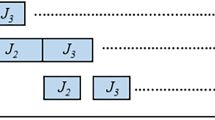Abstract
This article uses an integrated approach to solve real-world problems in three areas, namely single machine scheduling, 1-center location on networks and nonrenewable allocation problems. Jobs are stored at vertices and a single machine will be placed in the network. Each job receives an allocation that comes with a specific cost from an expected limited budget. Processing times of jobs are considered continuous functions of the allocation variables multiplied by costs, while release dates are defined as distances from job locations to the machine. We call this problem the scheduling-location problem with job allocation. The goal is to find a location on networks and an allocation to minimize a scheduling objective, makespan. We first consider the problem at a fixed location and propose a combinatorial algorithm that repeatedly solves continuous knapsack problems and runs in quadratic time. Concerning the original problem, we explore some properties of the objective function and develop a polynomial time algorithm to solve it.










Similar content being viewed by others
References
Balas E, Zemel E (1980) An algorithm for large zero-one knapsack problems. Oper Res 28:1130–1154
Bernheim BD, Whinston MD (1986) Menu Auctions, Resource Allocation, and Economic Influence. Q J Econ 101(1):1–31
Bhattacharya B, Shi Q, Tamir A (2009) Optimal algorithms for the path/tree-shaped facility location problems in trees. Algorithmica 55:601–618
Blazewicz J, Cellary W, Slowinski R, Weglarz J (1986) Scheduling under resource constraints—deterministic models. Ann Oper Res 7
Brown D (2002) Career choice and development. John Wiley & Sons, New Jersey
Brucker P (2007) Scheduling algorithms. Springer Verlag, Heidelberg
Christofides N, Alvarez-Valdes R, Tamarit JM (1987) Project scheduling with resource constraints: a branch and bound approach. Eur J Oper Res 29:262–273
Dawis RV, Lofquist LH (1984) A psychological theory of work adjustment: an individual differences model and its applications. University of Minnesota Press, Minnesota
Drexl A (1991) Scheduling of project networks by job assignment. Manag Sci 37(12):1590–1602
Drezner Z, Hamacher HW (2002) Facility location—applications and theory. Springer-Verlag, Berlin-Heidelberg
Hennes H (2005) Integrated scheduling and location models. Shaker Verlag, Aachen
Hennes H, Hamacher HW (2001) Integrated scheduling and location models: single machine makespan problem. Stud Locat Anal 16:77–90
Hessler CJ (2016) Scheduling-location algorithms with application in evacuation planning. Dr Hut Verlag, Müchen
Kalsch MT, Drezner Z (2010) Solving scheduling and location problems in the plane simultaneously. Comput Oper Res 37(2):256–264
Kariv O, Hakimi SL (1979) An algorithmic approach to network location problems. I: the \(p\)-centers. SIAM J Appl Math 37:513–538
Kariv O, Hakimi SL (1979) An algorithmic approach to network location problems. II: the \(p\)-medians. SIAM J Appl Math 37:539–560
Krumke SO, Le HM (2020) Robust absolute single machine makespan scheduling-location problem on trees. Oper Res Lett 48:29–32
Krumke SO, Le HM (2022) 2-approximation algorithm for minmax absolute maximum lateness scheduling-location problem. Oper Res Lett 50(6):732–737
Lai TCL, Chianglin CY, Yu PL (2008) Optimal adjustment of competence set with linear programming. Taiwan J Math 12(8):045–2062
Maheriya A, Patel J (2019) Improve makespan in job allocation using modified Hungarian algorithm in cloud computing. In: proceedings: https://api.semanticscholar.org/CorpusID:212731704
Peterson GW, Sampson JP, Reardon RC (1991) Career development and services: a cognitive approach. Thomson Brooks/Cole Publishing Co, California
Pham VH, Nguyen KT (2020) Inverse anti-\(k\)-centrum problem on networks with variable edge lengths. Taiwan J Math 24(2):501–522
Shahbazia B, Akbarnezhadb A, Reyc D, Ahmadian Fard Fini A (2018) A mathematical job allocation model to maximize career development opportunities for construction workers. In: Proceeding: International Association for automation and robotics in construction (IAARC) 761–766
Stinson JP, Davis EW, Khumawala BM (1978) Multiple resource constrained scheduling using branch and bound. AHE Trans 10:252–259
Talbot FB (1982) Resource-constrained project scheduling with time-resource trade-offs: the non-preemptive case. Manag Sci 28:1197–1210
Wei WH (2013) Robust estimation: location-scale and regression problems. Taiwan J Math 17(3):1055–1093
Wu P, Wang Y, Cheng J, Li Y (2022) An improved mixed-integer programming approach for bi-objective parallel machine scheduling and location. Comput Ind Eng 174:108813
Zhang C, Li Y, Cao J, Yang Z, Coelho LC (2022) Exact and metaheuristic methods for the parallel machine scheduling and location problem with delivery time and due date. Comput Oper Res 147:105936
Acknowledgements
We sincerely appreciate the valuable comments of anonymous referees, which helped to improve the paper. The first author (K.T. Nguyen) would like to thank the Ministry of Education and Training in Vietnam for funding his work under grant number B2024-TCT-22. The corresponding author (H.M Le) would like to thank Van Lang University, Vietnam for funding his work.
Author information
Authors and Affiliations
Corresponding author
Ethics declarations
Conflict of interest
We have no conflicts of interest to disclose.
Additional information
Publisher's Note
Springer Nature remains neutral with regard to jurisdictional claims in published maps and institutional affiliations.
Rights and permissions
Springer Nature or its licensor (e.g. a society or other partner) holds exclusive rights to this article under a publishing agreement with the author(s) or other rightsholder(s); author self-archiving of the accepted manuscript version of this article is solely governed by the terms of such publishing agreement and applicable law.
About this article
Cite this article
Nguyen, K.T., Le, H.M. An integrated approach for allocation and scheduling-location problems on graphs. Comp. Appl. Math. 43, 147 (2024). https://doi.org/10.1007/s40314-024-02650-5
Received:
Revised:
Accepted:
Published:
DOI: https://doi.org/10.1007/s40314-024-02650-5




